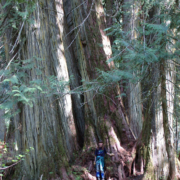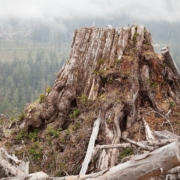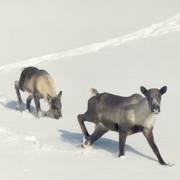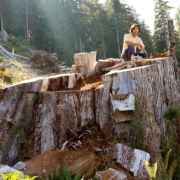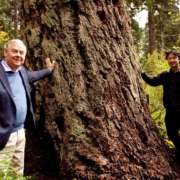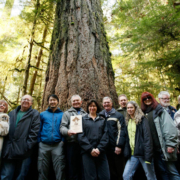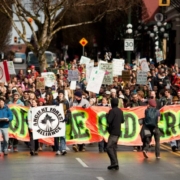Proposal for UN World Heritage Site for the Giant Cedars in BC’s Inland Rainforest Gains Momentum
Proposal for UN World Heritage Site for the Giant Cedars in BC’s Inland Rainforest Gains Momentum
Cooperation between conservationists across BC is ramping up a public awareness campaign to protect BC’s globally rare Inland Temperate Rainforest and to have one of its finest natural areas, highlighted by giant redcedars, designated as a UN World Heritage Site east of Prince George.
Conservationists in BC’s interior will join coastal activists to expand the awareness-raising campaign, including a presentation this Thursday, May 2 in Victoria (7-9 pm, Ambrosia Centre, 638 Fisgard St.) by Dr. Darwyn Coxson, Ecosystem Science & Management professor at the University of Northern British Columbia (UNBC), and Ancient Forest Alliance campaigners Ken Wu and TJ Watt of Victoria.
The “Ancient Forest Trail,” readily accessible from Highway 16, is located in B.C.’s Inland Temperate Rainforest, about 130 kilometers east of Prince George. It features massive western red cedars, some estimated to be over 1000 years old, and an internationally significant lichen flora. The area, known for generations to First Nations and other local communities, was flagged for harvesting in 2006 but subsequently declared off-limits to logging through an Old-Growth Management Area after a major public outcry. Surrounding and nearby old-growth and mature forests remain unprotected.
New research led by the University of Northern British Columbia shows that these old-growth cedar stands have been reduced to less than 4% of the 130,000 hectare forest type in which they are found (the “Interior Cedar Hemlock slim very wet cool” bioegeoclimatic zone or ICHvk2) – while only 96 hectares, or less than 0.1%, are currently protected in BC’s provincial parks. To help secure better representation of such forests, the report recommends the BC government extend the boundary of nearby Slim Creek Provincial Park to include the area surrounding the Ancient Forest Trail in the region around Dome Creek.
In effect this step is seen as preparatory to a bid for World Heritage Site status under the United Nations Educational, Scientific and Cultural Organization (UNESCO).
See: [Original UNBC.ca article no longer available]
“Becoming a Provincial Park or Conservancy and then a World Heritage Site will ensure the long-term protection of the ancient cedar stands, which to date, have been cared for by local community groups,” says the article’s lead author, UNBC Ecosystem Science and Management Professor Darwyn Coxson, who co-wrote the study with UNBC Environmental Planning professor David Connell, and Trevor Goward of the University of British Columbia. The study, which was published in the BC Journal of Ecosystems and Management, went through extensive peer review. It emphasizes that protected designation for this area would help to diversify the regional economy by building upon a regional tourist attraction, which has already developed at the area.
See the report at: https://jem.forrex.org/index.php/jem/article/view/206
B.C.’s temperate rainforests are best known on the coast, in such places as Clayoquot Sound, the Walbran and Carmanah Valleys, Avatar Grove, and the Great Bear Rainforest. However, another major tract of temperate rainforest, the Inland Temperate Rainforest, occurs in southeastern B.C ., stretching roughly from the Revelstoke area north to near Prince George. About 800,000 hectares of rainforest ecosystem exists in B.C.’s Interior within the wettest portions of the Interior Cedar Hemlock zone, with huge redcedars and diverse wildlife including grizzlies, wolverine, and the endangered mountain caribou. The ecosystem is also well known for for its exceptional lichen diversity, specifically linked to old-growth forests. Unfortunately, a quarter century of logging has eliminated the vast majority of old-growth stands within this ecosystem.
“While BC has many incredibly diverse forest types, there’s no doubt that one of the most charismatic – and heavily hit by the logging industry – has been the old-growth Inland Temperate Rainforests with its thousand year old cedars. These are among Earth’s most spectacular forests, and the BC government needs to protect them for wildlife, tourism, the climate, and First Nations cultures,” stated Ken Wu, Ancient Forest Alliance executive director. “Not only do specific areas like the 16,000 hectares around the Ancient Forest Trail need strong legislated protection, but we also need a more comprehensive Provincial Old-Growth Plan to protect endangered old-growth forests across BC, including our remaining old-growth Inland Temperate Rainforests.”
“Temperate rainforests are limited to about a half dozen widely scattered regions in both hemispheres. Of these the inland temperate rainforest formation occurs in only two: western Canada and southern Europe. B.C. has the only such tracts on the planet that can in any sense be called pristine. This must be seen as a globally-significant conservation priority,” stated lichenologist Trevor Goward, co-author of the report and contributor to the award-winning book, Temperate and Boreal Rainforests of the World, published in 2011.
The Ancient Forest Alliance is calling on the BC government to establish a comprehensive, science-based Provincial Old-Growth Plan. The plan would entail protection targets and timelines to ban or quickly phase-out old-growth logging in regions where scientific assessments deem it necessary to sustain ecosystem integrity, while at the same time the government is encouraged to ensure a value-added second-growth forest industry with a reduced, sustainable rate of cut.
Authorized by the Ancient Forest Alliance, registered sponsor under the Election Act
Ancient Forest, Alliance, Victoria Main PO, PO Box 8459, Victoria, BC, V8W 3S1 Canada

